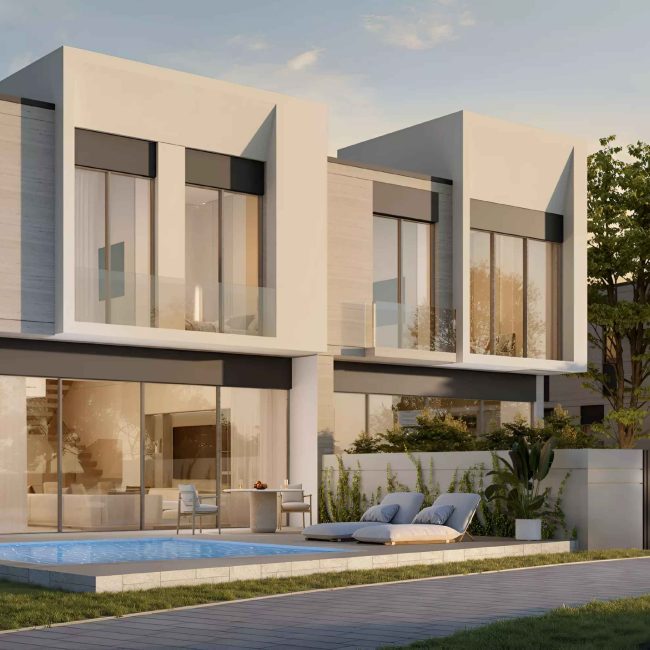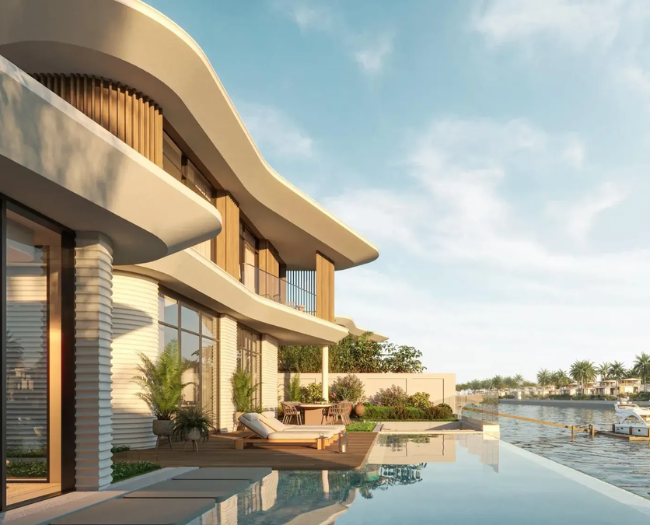Villas for Sale in Dubai | Luxury & Family Homes in Top Communities
Dubai’s villa market has evolved into one of the most sought-after segments in the global real estate landscape. With a unique mix of luxury, lifestyle, and strong return potential, villas for sale in Dubai continue to attract both end-users and investors worldwide. Whether you’re searching for a serene family retreat or a high-end beachfront estate, Dubai’s villa communities offer a diverse range of properties catering to every lifestyle and investment goal.

Why Buy a Villa in Dubai?
The price of a villa in Dubai varies based on factors such as location, plot size, community amenities, and property type—whether it’s a standalone villa, semi-detached unit, or townhouse. Premium areas like Palm Jumeirah and Dubai Hills Estate command higher prices due to beachfront access or golf course views, while emerging communities offer more affordable options with strong ROI potential. Overall, villa prices in Dubai remain attractive compared to major global cities, making it a compelling destination for luxury living and long-term investment.
Dubai boasts a wide range of villa neighborhoods, from family-friendly suburbs to ultra-luxury waterfront estates. Here are the top-performing areas in 2025:
1. Dubai Hills Estate
- Average Price (5-bed): AED 10–15M
- Rental Yield: 5.3%
- Offers modern design, central park access, international schools, and proximity to Downtown Dubai.
2. Palm Jumeirah
- Average Price (5-bed): AED 20–35M
- Rental Yield: 4.5%
- Dubai’s iconic island featuring beachfront villas, celebrity neighbors, and unparalleled views of the Arabian Gulf.
3. Arabian Ranches 2 & 3
- Average Price (4-bed): AED 4.2–6M
- Rental Yield: 5.8%
- One of the most family-friendly zones with gated security, schools, and green parks.
4. The Villa – Dubailand
- Average Price (5-bed): AED 3.5–6.5M
- Rental Yield: 6.2%
- Affordable luxury villas with Spanish-inspired architecture and spacious layouts.
5. Jumeirah Golf Estates
- Average Price (5-bed): AED 6–12M
- Rental Yield: 5.9%
- Ideal for golf lovers and nature enthusiasts with stunning course-facing properties.
Villa Price Trends in Dubai (2025)
Based on June 2025 market reports:
- Average villa price: AED 4M
- YoY change: –0.2%
- Despite a slight correction from previous highs, prime villa communities continue to witness active resale and rental demand.
Price stabilization reflects maturing buyer behavior and a balanced market, especially in mid-luxury and emerging areas like Al Furjan and Tilal Al Ghaf.
Factors Influencing Villa Prices in Dubai
The price of villas in Dubai is shaped by a combination of market dynamics, community features, and buyer demand. Understanding these factors is essential for making informed investment or purchasing decisions:
Location & Neighborhood
Proximity to the beach, business districts (like Downtown or DIFC), schools, and public infrastructure plays a critical role. Villas in upscale areas such as Palm Jumeirah, Emirates Hills, and Dubai Hills Estate command premium prices due to exclusivity, security, and lifestyle offerings.
Property Type & Configuration
Standalone villas with larger plot sizes and private amenities (such as pools, gardens, or basements) are priced higher than semi-detached or townhouses. The number of bedrooms, architectural style, and layout efficiency also affect valuation.
Community Amenities
Gated communities offering golf courses, lakes, parks, fitness centers, and family-centric amenities generally see higher price appreciation. Buyers are willing to pay more for access to green spaces and recreational facilities.
View & Orientation
Villas with sea, skyline, golf course, or park views are considered premium and command higher prices. Orientation also matters—homes facing sunrise or with unobstructed views tend to be priced more competitively.
Developer Reputation & Build Quality
Projects by top-tier developers like Emaar, Nakheel, or Meraas often carry a brand premium. Build quality, smart home features, sustainability certifications, and post-handover services significantly influence buyer confidence and pricing.
Market Demand & Supply Trends
The balance of villa inventory versus buyer demand impacts prices. In high-demand periods (e.g., post-COVID luxury migration), prices surged. Price trends may also vary seasonally or based on investor sentiment and global market conditions.
Future Infrastructure & Connectivity
Planned metro lines, highways, malls, or schools near a villa community can lead to price appreciation. Government-backed master plans like Dubai 2040 also impact future value.
Tips for Investors
1. Consider Off-Plan Villas
Projects like Elan by Majid Al Futtaim and Park Greens by DAMAC offer attractive entry prices, post-handover payment plans, and strong capital growth potential. Investing early in these communities can yield significant appreciation by handover.
2. Understand Maintenance Costs
Annual service fees can vary greatly depending on the developer and amenities offered. Premium gated communities may have higher upkeep costs, so it’s important to factor this into your ROI projections.
3. Explore Short-Term Rental Opportunities
In popular tourist areas like Palm Jumeirah, JBR, and JVC, short-term villa rentals often outperform long-term leases in terms of yield. Ensure that your property is approved for holiday rentals and registered with Dubai Tourism if required.
4. Focus on Sustainable Communities
Eco-conscious developments like The Sustainable City are increasingly attractive to buyers and renters. These properties offer lower utility costs and long-term value aligned with Dubai’s 2040 urban development vision.

Key Strategies While Investing in Dubai's Villa Market:
Focus on emerging communities with strong infrastructure, such as Dubai Hills Estate and Arabian Ranches 3, where villa prices are still on the rise. Prioritize properties with flexible post-handover payment plans and high rental demand for long-term value and liquidity.
1. Leverage the Potential of Off-Plan Villas for Capital Growth
Investing in off-plan villas remains one of the most effective ways to achieve higher capital appreciation and lower entry costs. Prominent developments such as Elan at Tilal Al Ghaf by Majid Al Futtaim or Park Greens by DAMAC provide flexible post-handover payment plans and launch pricing significantly below the resale market. These properties are often located in emerging communities designed around walkability, community parks, and premium amenities. As infrastructure and demand build over the coming years, early investors are well-positioned to benefit from value appreciation upon handover. It’s important to carefully assess the developer’s track record, delivery timelines, and the master plan’s long-term viability before committing.
2. Plan for Operational Costs Like Maintenance and Service Fees
One of the often-overlooked aspects of villa investment is the ongoing cost of ownership. Annual service charges, maintenance fees, and utility bills can vary dramatically based on the community, facilities, and developer. For example, gated villa compounds with extensive landscaping, pools, gyms, and concierge services may command higher annual charges than standalone or semi-detached homes in less amenitized zones. Investors should calculate their net ROI (Return on Investment) after accounting for these costs and consider whether to self-manage or appoint a property management company to streamline operations. Also, be mindful of vacancy periods and upkeep requirements, particularly for luxury villas that need regular maintenance to preserve rental or resale value.
3. Maximize Rental Returns with Short-Term Lettings
Dubai’s short-term rental market has grown rapidly, driven by digital nomads, tourists, and business travelers. Villas in popular areas like Palm Jumeirah, JVC, and JBR are ideal for holiday rentals and often deliver higher returns than long-term leases. Platforms such as Airbnb and Booking.com, along with Dubai Tourism’s Holiday Home program, make management accessible. However, investors must check whether short-term rentals are permitted in their chosen community and obtain the necessary licenses. Hiring a professional rental manager can help optimize occupancy and ensure a quality guest experience.
4. Prioritize Green and Sustainable Communities for Long-Term Appeal
Dubai’s real estate landscape is evolving to reflect sustainability trends and eco-conscious buyer preferences. Communities like The Sustainable City, Masaar, and newer phases in Tilal Al Ghaf are being developed with green infrastructure, solar power, waste recycling systems, and low-carbon footprints. These features are increasingly valued not just by end-users but also by institutional investors and ESG-aligned portfolios. Villas in these neighborhoods often have lower utility costs, enhanced wellness amenities, and long-term value appeal as Dubai aligns its real estate market with the Dubai 2040 Urban Master Plan. For forward-thinking investors, green communities represent a smart hedge against future regulatory shifts and lifestyle changes.
Frequently Asked Questions
1. Can foreigners buy villas in Dubai?
Yes, non-UAE nationals can purchase villas in designated freehold areas such as Arabian Ranches, Emirates Hills, and Palm Jumeirah. Dubai’s 2002 Freehold Law allows full ownership rights for investors in these zones.
2. What are the best areas to buy a villa in Dubai?
Top villa communities include:
- Palm Jumeirah – iconic waterfront mansions
- Arabian Ranches – family-oriented with golf courses
- Emirates Hills – ultra-luxury gated enclave
- Dubai Hills Estate – modern amenities and family-friendly parks
3. What is the typical price range for villas in Dubai?
Prices vary widely:
- Entry-level villas in areas like Dubai Hills Estate start around AED 1.5 million
- Luxury villas, especially on Palm Jumeirah or Emirates Hills, can exceed AED 50–100 million
4. What additional costs are involved in buying a villa in Dubai?
Expect about 8% extra costs, including:
- 4% Dubai Land Department transfer fee
- 2% agency commission
- 0.25% mortgage registration (if applicable)
- Valuation, NOC, and service fees
5. How long does it take to complete a villa purchase in Dubai?
The average transaction is completed in 30–60 days, depending on financing, documentation, and developer readiness
6. Do villa buyers in Dubai get residency visas?
Yes. Investing AED 750,000+ qualifies for a 2-year residency visa, while AED 2 million+ may grant a 10-year Golden Visa
7. Should I buy off-plan or ready villas?
- Off-plan: Lower entry prices and flexible payment plans—but with delivery risks
- Ready: Immediate occupancy or rental, though prices are higher.
8. What financing options are available for villa buyers?
Both residents and non-residents can obtain mortgages up to 75–80% LTV. Non-resident terms may involve larger down payments and stricter checks
9. What rental yields can investors expect from villas?
Villas in family-focused areas like Arabian Ranches and Dubai Hills Estate can produce yields of 5–7%, supported by strong rental demand from expats and families.
10. What documents are required to buy a villa in Dubai?
Essential documents include:
- Valid passport and visa
- Proof of address
- Bank statements and income proof
- NOC (for resales)
- SPA and Title Deed issued via the Dubai Land Department
